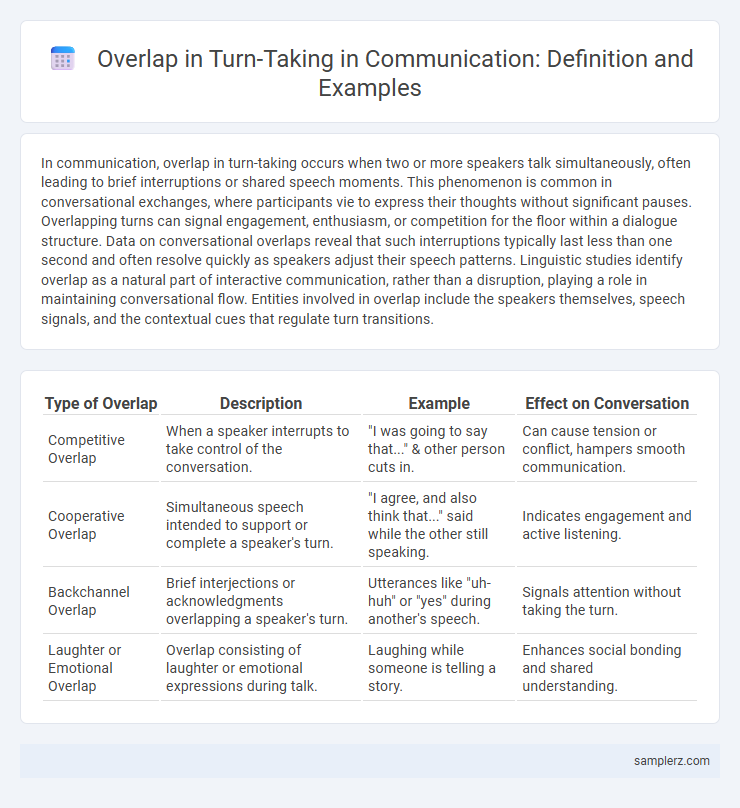In communication, overlap in turn-taking occurs when two or more speakers talk simultaneously, often leading to brief interruptions or shared speech moments. This phenomenon is common in conversational exchanges, where participants vie to express their thoughts without significant pauses. Overlapping turns can signal engagement, enthusiasm, or competition for the floor within a dialogue structure. Data on conversational overlaps reveal that such interruptions typically last less than one second and often resolve quickly as speakers adjust their speech patterns. Linguistic studies identify overlap as a natural part of interactive communication, rather than a disruption, playing a role in maintaining conversational flow. Entities involved in overlap include the speakers themselves, speech signals, and the contextual cues that regulate turn transitions.
Table of Comparison
| Type of Overlap | Description | Example | Effect on Conversation |
|---|---|---|---|
| Competitive Overlap | When a speaker interrupts to take control of the conversation. | "I was going to say that..." & other person cuts in. | Can cause tension or conflict, hampers smooth communication. |
| Cooperative Overlap | Simultaneous speech intended to support or complete a speaker's turn. | "I agree, and also think that..." said while the other still speaking. | Indicates engagement and active listening. |
| Backchannel Overlap | Brief interjections or acknowledgments overlapping a speaker's turn. | Utterances like "uh-huh" or "yes" during another's speech. | Signals attention without taking the turn. |
| Laughter or Emotional Overlap | Overlap consisting of laughter or emotional expressions during talk. | Laughing while someone is telling a story. | Enhances social bonding and shared understanding. |
Understanding Overlap in Conversational Turn-Taking
Overlap in turn-taking occurs when two or more speakers talk simultaneously, often signaling active engagement or eagerness in conversation. This phenomenon can indicate cooperative communication, such as providing support or displaying enthusiasm, but it may also cause interruptions that hinder mutual understanding. Analyzing timing, intonation, and context helps unravel whether overlap facilitates seamless dialogue or disrupts conversational flow.
Common Scenarios Where Overlap Occurs
Overlap in turn-taking frequently occurs in fast-paced conversations such as debates, where speakers attempt to assert points simultaneously. Overlapping also happens during informal group chats, especially when multiple participants are eager to contribute or respond quickly to shared topics. These common scenarios highlight the dynamic nature of conversational flow and the negotiation of speaking turns to maintain engagement.
Types of Overlapping Speech in Dialogue
Overlapping speech in dialogue includes types such as cooperative overlap, where speakers interject briefly to show engagement or support, and competitive overlap, characterized by interruptions that signal dominance or disagreement. Simultaneous speech can also occur during high-paced exchanges, often reflecting enthusiasm or urgency. These overlaps influence conversational flow and impact the interpretation of speaker intent and interaction dynamics.
Causes of Overlap During Turn Exchange
Overlap during turn exchange often occurs due to simultaneous speech initiation when two or more speakers attempt to take the floor at once. This phenomenon is commonly driven by high engagement levels or urgency in the conversation, prompting participants to interject before the current speaker finishes. Cognitive processing delays and anticipation errors also contribute to overlaps, as listeners misjudge the end of a turn or the speaker's intent to yield the floor.
Overlap as a Sign of Engagement or Interruption
Overlap in turn-taking often signals active engagement, where listeners demonstrate attentiveness by interjecting to affirm or build on the speaker's point. This form of simultaneous speech can strengthen conversational rapport, showing enthusiasm and immediate feedback. However, overlap may also function as an interruption, disrupting the speaker's flow and indicating disagreement or dominance in the dialogue.
Cultural Differences in Overlapping Talk
In communication, cultural differences significantly influence patterns of overlapping talk during turn-taking, with some cultures perceiving overlaps as signs of engagement and enthusiasm, such as in Mediterranean or Latin American interactions. In contrast, East Asian cultures often view overlapping speech as interruptions indicating impatience or disrespect, prioritizing smooth, non-overlapping exchanges. Understanding these cultural variations helps improve cross-cultural communication, reducing misunderstandings arising from differing interpretations of overlapping talk.
Strategies for Managing Overlap in Conversations
In conversations, overlap occurs when two or more participants speak simultaneously, creating potential disruption in the turn-taking process. Strategies for managing overlap include using subtle verbal cues such as lowering volume or pausing briefly to signal deference, and employing nonverbal signals like eye contact or hand gestures to indicate a willingness to yield the floor. Effective overlap management enhances conversational flow and reduces misunderstandings in diverse communication settings.
Effects of Overlapping Turns on Communication Flow
Overlapping turns in communication often lead to interruptions that disrupt the natural flow of conversation, causing misunderstandings and reducing message clarity. This overlap can heighten speaker anxiety and diminish active listening, ultimately impairing effective information exchange. Research shows that managing overlapping turns with cooperative cues improves conversational coherence and participant engagement.
Overlap in Virtual vs. Face-to-Face Communication
Overlap in turn-taking occurs when multiple participants speak simultaneously, often seen in face-to-face communication through natural interruptions or backchanneling cues. In virtual communication, overlap tends to be more disruptive due to latency issues, causing participants to talk over each other without the immediate visual or auditory feedback that aids in managing turns. Effective strategies to minimize overlap online include using visual signals, structured turn-taking protocols, and platform features like hand-raising functions.
Analyzing Real-Life Examples of Turn-Taking Overlap
Turn-taking overlap frequently occurs in natural conversations, such as two colleagues simultaneously responding to a question during a meeting, revealing negotiation of speaking rights. Analyzing real-life examples helps identify patterns like interruption, backchanneling, or cooperative overlap, which contribute to conversational flow and social dynamics. Detailed examination of these overlaps offers insights into speakers' intentions, turn allocation fairness, and communication efficiency in various contexts.

example of overlap in turn-taking Infographic
 samplerz.com
samplerz.com